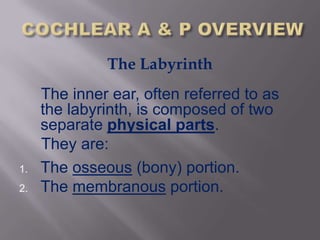
Cochlear anatomy & physiology overview
- 1. The Labyrinth The inner ear, often referred to as the labyrinth, is composed of two separate physical parts. They are: 1. The osseous (bony) portion. 2. The membranous portion.
- 2. Osseous portion Contains the: 1. Perilymph fluid 2. Cochlea 3. Three semicircular canals 4. Vestibule
- 3. Membranous portion Contains the: 1. Endolymph fluid 2. Saccule 3. Utricle 4. Cochlear duct
- 4. The inner ear consists of two major functional parts. They are: 1. The vestibular portion (balance) 2. The cochlear portion (hearing)
- 5. The cochlea is one of the most complicated organs in the body, but its purpose is simple. It changes sound into electricity and electricity is the “language” the BRAIN understands.
- 6. The size of the cochlea is relatively small—about the size of the tip of your little finger. Its diameter is about that of the tympanic membrane. Its snail shape has only two and a half turns in humans, and varies among other mammals.
- 7. The cochlea is almost completely formed by the end of the first trimester of pregnancy. Hearing (the cochlea) is one of the first senses of embryonic development for electrical stimulation of the brain.
- 8. The cochlea is located within the petrous portion of the temporal bone. The bony labyrinth is the hardest bone within the human body.
- 9. The Cochlea It is a fluid filled cavity which is divided into three canals. They are: 1. The scala vestibuli 2. The scala media (cochlear duct) 3. The scala tympani
- 10. The top chamber of the scala vestibuli begins at the oval window and ends at the helicotrema.
- 11. The scala media is the middle chamber where the hair cells are located. It is separated from the scala tympani by the basilar membrane upon which the Organ of Corti (where the hair cells are) is resting.
- 12. The scala tympani begins at the round window and meets the scala vestibuli at the helicotrema (the apex of the cochlea) The scala tympani and the scala vestibuli share the same perilymphatic fluid (the fluid is mostly potassium—less sodium)
- 13. The scala media has a more thick endolymph fluid which consists of exactly the opposite proportions of potassium and sodium relative to the perilymph fluid.
- 14. Perilymph has a viscosity similar to water. The cochlear duct (scala media) includes endolymph, hair cells, the tectorial membrane and the basilar membrane. It is the consistency of gelatin. There is no physical discontinuity between the cochlear duct (scala media) and the perilymph fluid.
- 15. Cochlear blood supply Is very complex, but primary supplies are around the scala media area. The stria vascularis maintains the chemical composition of the endolymph. There are a group of small blood vessels just below the basilar membrane which supply the organ of Corti with nutrients.
- 16. Cochlear blood supply Please note, there is no direct contact with the vascular system and the structures of the cochlea. There is an “intermediate transfer system” through the intracochlear fluids of each site.
- 17. Perilymph fluid movement Since the bony portion of the labyrinth is solid, the only release for fluid movement is the round window. If the round window was solid bone, the stapes would be unable to move the fluid from the oval window side.
- 18. Characteristics of the Basilar Membrane It is about .1mm at its base increasing in width to about .5mm at its apex. Its stiffness is about one hundred times greater at its base than its apex. These characteristics become the determinants of its frequency response patterns.
- 19. Characteristics of the Basilar Membrane There are transverse bands (side-to-side) which are located along the length of the basilar membrane. These transverse bands vary in stiffness as they are spaced along the basilar membrane. Each band is (frequency) sensitive to the various waves of energy received along the traveling wave pathway.
- 20. Characteristics of the Traveling Wave The first portion of sound stimulus wave undulation of the basilar membrane is generally received close to the stapes. The wave continues with increased undulation to a maximum point along the basilar membrane; this maximum amplitude point is dependent upon the frequency of the stimulus.
- 21. Characteristics of the Traveling Wave The point of maximum amplitude for high frequencies is closest to the basal end; while the maximum amplitude for low frequencies is closer to the apical end.
- 22. Characteristics of the Traveling Wave The velocity and therefore the wavelength decrease as a function of distance from the stapes. This reduction of amplitude, velocity, and wavelength is commonly found with any sound transmission through a fluid.
- 23. Characteristics of the Traveling Wave This frequency dependent maximum basilar membrane displacement is a clear indication that the cochlea performs a mechanical frequency analysis. This is defined as the Place Theory of frequency resolution.
- 24. Let’s review figure 1-1 in Venema page #2
Editor's Notes
- We will also review the new cochlea cross-section with the organ of corti.
